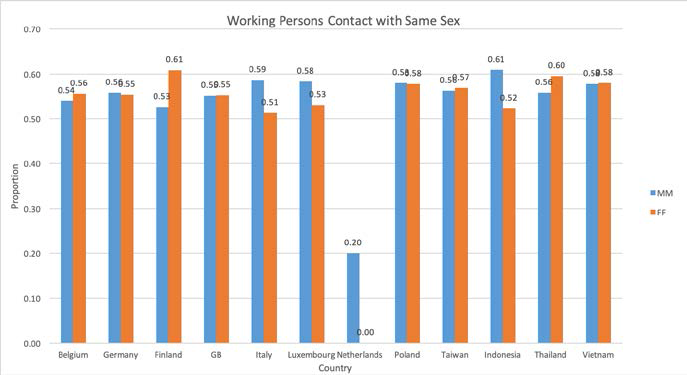性別化的社會網絡與身心福祉:多元交織性的研究取徑
Gendering social networks and individual wellbeing: An intersectionality approach
本計畫旨在比較性別角色與健康不平等、社會網絡不平等的關聯,從而發展「跨國交叉性」的綜合研究觀點。已執行的計畫期間聚焦於分析兩大代表性抽樣調查資料:(1)跨及歐洲八國和亞洲四國的抽樣調查,包含各受訪者的24小時接觸日記;(2)2017年國際社會調查計劃(ISSP)有關「社會網絡和資源」的調查資料,資料涵蓋全球各大洲的30個國家。分析結果初步顯示性別不平等現象在國家/地區間的差異明顯。總體而言,性別與個人網絡之間的關係反映了國家層次的性別不平等總體指標。此外,在歐洲及亞洲性別不平等指數較高的國家中,男性就業人口比女性更常和同性別的人接觸。進一步以接觸的場合來劃分,則男性在工作場合和同性別接觸的比例更要明顯高於女性。但是在休閒和其他場合中這種「同質接觸」比例並沒有明顯的性別差異。
This project aimed to develop an integrated perspective of “transnational intersectionality” by comparing how gender roles link to inequalities in both health and social networks across countries. We retrieved and analyzed representative survey data from two major sources: (1) simultaneous representative surveys on social contacts across eight countries in Europe and four countries in Asia, including a 24-hour contact diary for every survey respondent; (2) the 2017 survey module on “social networks and resources” of the International Social Survey Programme (ISSP), which covers 30 countries from all major continents. We found significant differences in gender inqualities across some countries. Overall, the relationships between gender and personal networks reflect the extent of gender inequality at the country level. In both European and Asian countries, for example, males tend to have more same-gender contacts among working subpopulations when the macro-level indices of gender inequalities are higher. In these countries, furthermore, the same-gender tendency becomes even more obvious at work for males. Such a gender difference in “homophilous contact”, however, is much less evident on leisure and other occasions.
 Figure 1. Same-gender daily contacts among working persons across 12 countries
Figure 1. Same-gender daily contacts among working persons across 12 countries
